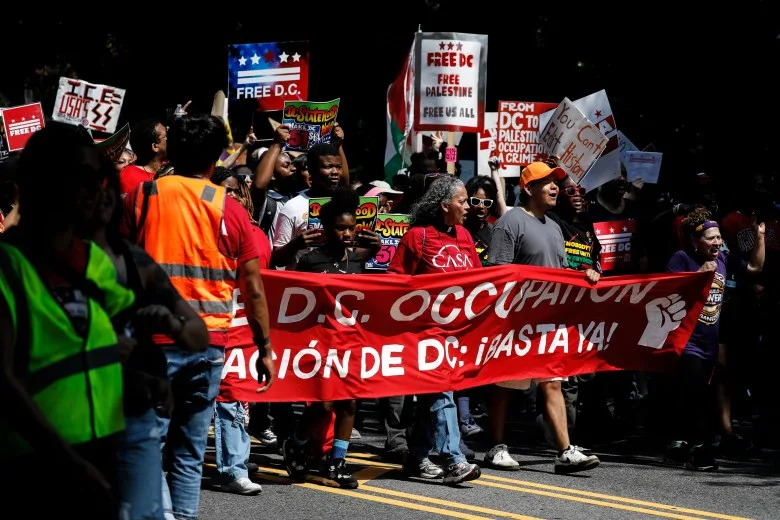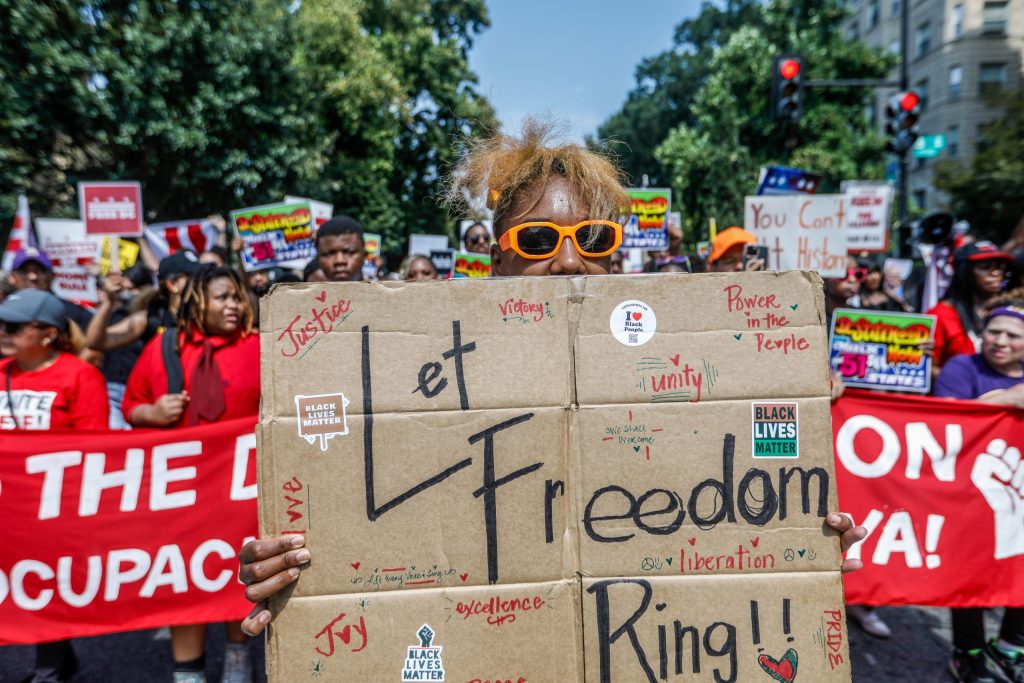President Donald Trump’s continued efforts to deport undocumented immigrants and what he says is a crackdown on crime in mostly Democratic-led cities — which have some of the nation’s largest Black populations — is showing no signs of slowing.
Yet on Thursday, Chicago won a battle for now. A judge temporarily blocked the deployment of National Guard troops in the Chicago area for at least two weeks. The judge said the order would expire on Oct. 23 at 11:59 p.m. She set an Oct. 22 hearing by telephone to determine if the order should be extended for another 14 days.
After weekend protests and just days after a massive raid, Chicago and Illinois sued to stop Trump’s National Guard deployment plan. Chicago Mayor Brandon Johnson and Gov. JB Pritzker have been trading jabs with the Trump administration for weeks.
The judge said the Trump administration violated the 10th Amendment of the Constitution, which grants certain powers to states, and the 14th Amendment, which assures due process and equal protection. She found no substantial evidence that a “danger of rebellion” is brewing in Illinois during Trump’s immigration crackdown, the Associated Press reported.
“The court confirmed what we all know: There is no credible evidence of a rebellion in the state of Illinois. And no place for the National Guard in the streets of American cities like Chicago,” Pritzker said.
So far, the National Guard troops have been deployed to Chicago, Los Angeles, Memphis, Tennessee, and Washington, D.C., despite local crime data showing reductions in violent crime, including homicides, in several of these cities. In Portland, Oregon, a federal judge temporarily blocked the administration’s attempt to send in hundreds of National Guard troops from California and from Texas, following an agreement with its Republican governor.
Since June, the administration has faced lawsuits from four state attorneys general over its deployment — or attempted deployment — of National Guard troops into cities Trump has said requires federal intervention to restore order.
Here’s how the National Guard deployments unfolded in each city:
Chicago pushing back
Black residents in Chicago told Capital B they fear being increasingly targeted after learning about a recent U.S. Supreme Court ruling that allows Immigration and Customs Enforcement to consider race as one factor during certain raids. This is a concern supported by research showing Black and brown people are already more likely than white residents to be stopped by police, especially during traffic stops.
On Sept. 8, ICE launched Operation Midway Blitz with the mission to arrest alleged undocumented “criminals” who sought refuge in Illinois under sanctuary policies enforced by Pritzker, according to a press release about the operation.
Three years prior, the city had an influx of thousands of African, Caribbean, South and Central American asylum-seekers bused from Texas, causing conflict amongst Chicago residents who were already in need. For decades, individuals have immigrated to the Windy City without safety concerns from their home country, and have legally obtained their citizenship.
Protests ensued in Chicago’s downtown as ICE raids popped up within predominantly Black and brown communities across the city. To date, nearly 900 undocumented immigrants had been arrested by ICE, according to federal officials.
Pritzker and Johnson warned Trump not to send the National Guard into Illinois, or Chicago, which has reported the lowest homicide rates in decades. Johnson signed an executive order preventing local police from cooperating with ICE, and another that creates “ICE-free zones” that limits where federal agents can gather in the city for immigration enforcement activities.
As joint efforts from elected officials seemed to hold off Trump’s deployment of the National Guard into Chicago, Pritzker said the administration put pressure on him to deploy the National Guard as Trump ordered 400 National Guards from Texas to deploy across the country.
Following an ICE raid of an apartment building on the South Side on Oct. 1 that resulted in the arrest of 37 undocumented people, Kwame Raoul, the state’s attorney general, filed a lawsuit calling for a federal judge to block the administration’s “unlawful deployment of National Guard members in Illinois.”
Leaders divided in Memphis
As Washington, D.C.’s takeover was coming to an end and without any extension in sight on Sept. 10, the administration redirected its focus to Memphis. Trump called the majority Black city “deeply troubled” and said that “we’re going to fix that just like we did Washington.”
Negating that homicide rates are at their lowest in six years, the National Guard was deployed there at the urging of Republican Tennessee Gov. Bill Lee. Unlike Chicago, Los Angeles, and Portland, Lee welcomed a federal takeover without consulting with Paul Young, the city’s Democratic mayor.
Young said he wasn’t “happy” with the deployment of the troops, and didn’t think it would help with reducing crime to get the city off any “bad lists.”
Community leaders remain divided over the takeover.
“Their stated goal is to end crime, and I think that’s going to be hard to actually end it altogether, and so there’s no specific target,” Young said. “They have not given a specific date for how long they will be here.”
On Oct. 10, National Guard troops began patrolling the streets of Memphis.
Ongoing litigation in Portland
In response to immigration enforcement protests, Trump ordered Defense Secretary Pete Hegseth in September to send the National Guard into what Trump called, “war ravaged Portland” to protect ICE facilities.
Hours after Trump’s order, Oregon’s attorney general filed a lawsuit in September against the administration to stop the “unlawful deployment” of troops from across the state and California into the city, since protests against ICE enforcement did not rise to a rebellion.
The administration was set to deploy 200 troops into Portland for 60 days.
On Oct. 4, a Trump-appointed federal judge in Oregon temporarily blocked the deployment of National Guard members from anywhere in the U.S. to the city.
Yet on Oct. 9, judges from the U.S. Court of Appeals for the Ninth Circuit signaled they could clear the way for the deployment of National Guard troops, and pause the lower-court ruling that found that Trump may have exceeded his authority by declaring a “rebellion” where there was none. Litigation continues.

Protesters demonstrate in Washington last month against the federal government’s takeover of the city’s police department. Under the Home Rule Act, presidents can commandeer the city’s police department for up to 30 days. (Yasin Ozturk/Anadolu via Getty Images)
What made Washington, D.C., different
In early August, Trump signed a flurry of executive orders following an attempted unarmed carjacking and assault of a 19-year-old former Department of Government Efficiency employee in the Logan Circle neighborhood. A pair of 15-year-old teenagers were charged. One teen, a boy, pleaded guilty in juvenile court in September to felony assault, simple assault, robbery, and attempted robbery charges. Sentencing is scheduled for the end of October.
An Aug. 11 executive order included a federal takeover under D.C.’s Home Rule Act. That was followed by a directive from Attorney General Pam Bondi to local police to cooperate with ICE regardless of any city law, and added immigration enforcement to their tasks.
Unlike other jurisdictions on Trump’s watch list, Washington, D.C. is not a state and does not have a governor. But, Brian Schwalb, its attorney general, filed a lawsuit to stop the administration’s takeover of the local police department. Mayor Muriel Bowser initially pushed back on Trump’s enforcement efforts since the area had experienced a 30-year overall drop in crime.
Over time, Bowser shifted her language, referring to the “federal takeover” as a “surge,” and by correcting journalists in press briefings. As the expiration of the Home Rule Act approached on Sept. 10, she faced criticism for signing an executive order to continue cooperating with the federal government — a move Bowser explained was part of a broader plan to end the takeover.
Six Republican-led states sent hundreds of their National Guard troops into the nation’s capital to assist local law enforcement efforts. During the 30-day siege, officers targeted low-income neighborhoods, leading to the arrests of mostly Black men and more than 900 immigrants, according to a Washington Post analysis.
What’s happened in Los Angeles
In June, dozens of migrants were arrested following ICE raids in Los Angeles’ Fashion District, Boyle Heights, and Pico-Union neighborhoods. Protests erupted.
As a response, Trump directed 2,000 Guard troops from across the state into Los Angeles for 60 days. This action was taken without authorization from California Gov. Gavin Newsom or Los Angeles Mayor Karen Bass, both Democrats.
Bass said in an interview with CNN that the president was “creating warfare within cities.”
The state’s attorney general, Rob Bonta, and Newsom filed a lawsuit against the Trump administration for “an inflammatory escalation unsupported by conditions on the ground.” The multiple days of protests had not risen to the level of “rebellion” to deploy the National Guard into the city at the time, the lawsuit said. Bonta told CBS News that most of the protests were peaceful “except some instances of violence.”
Crime in the city decreased in 2024, according to police data. Homicide and shooting victims have decreased by 14% and 19%, respectively.
As of Oct. 8, National Guard troops in California have been ordered by the administration to head to Portland and Chicago. Bonta said in court filings that the move “dramatically broadened” the administration’s efforts to use California’s crop of National Guards “for activities unrelated to protecting federal personnel and buildings.”
The litigation is ongoing.
The post A City-by-City Breakdown of Trump’s Immigration Raids and Troop Deployments appeared first on Capital B News.
